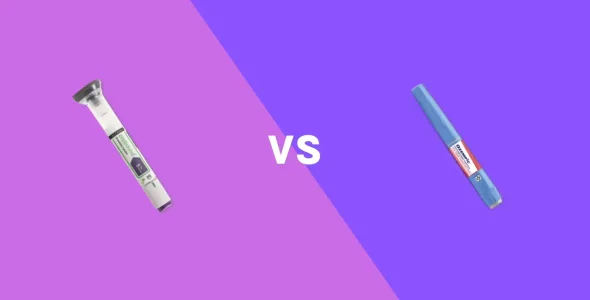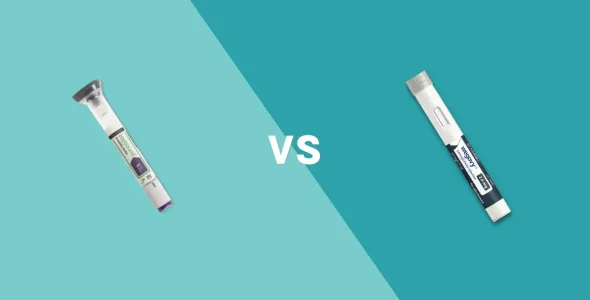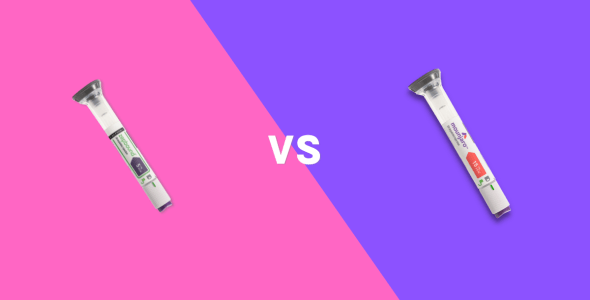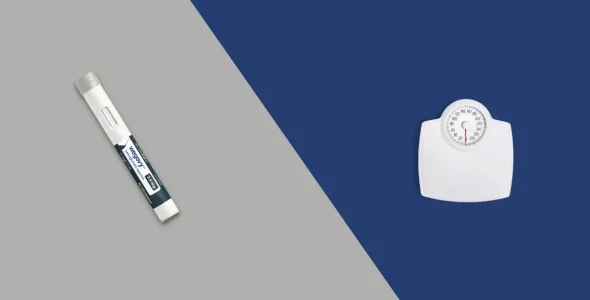What is the best injection for weight loss? The Ultimate Guide
Key highlights
- The FDA has approved Wegovy (semaglutide), Zepbound (tirzepatide), and Saxenda (liraglutide) for weight loss in obese and overweight adults. Saxenda can also be used in adolescents.
- Based on clinical trials, Zepbound (tirzepatide) is the most effective weight loss drug for overweight and obese individuals, with the potential of up to 25% weight loss.
- Medications like Ozempic (semaglutide), Mounjaro (tirzepatide), Botox, and Vitamin B12 approved for other indications are also used off-label for weight loss.
- Some drugs like Retratrutide, CagriSema, Ecnoglutide, Mazdutide, Survodutide, and Bimagrumab have also shown effectiveness in weight loss, and are undergoing clinical trials.
- Common side effects of weight loss injections include nausea, diarrhea, and constipation. Some serious side effects of weight loss drugs may include gallbladder disease, pancreatitis, hypoglycemia, changes in vision, allergic reactions, and kidney issues.
- The cost of weight loss drugs may vary depending on the prescribed medication, the pharmacy you buy from, and your insurance coverage.
- Depending on the medication, people may lose an average of 4% - 21% of their body weight.
According to WHO, 2.5 billion adults were overweight in 2022. Out of these, 890 million were living with obesity. In the US, more than two in five adults are obese.
Moreover, the Centers for Disease Control and Prevention mention that people with obesity have a higher risk of health conditions like diabetes type 2, high blood pressure, high cholesterol, heart diseases, joint problems, breathing issues, gallbladder diseases, many types of cancer, mental illness, and premature death.
Usually, doctors suggest lifestyle modifications and physical activity to reduce weight and maintain a healthy BMI. However, sometimes, people with health issues like diabetes may have severe obesity and need medication to help with weight loss.
There are various FDA-approved weight loss medications to help you live a healthy life. They are effective in suppressing your appetite and reducing hunger. This article details the best weight loss injections with their mechanism of action, administration method, costs, and more so you’ll have all the information you need before speaking with your healthcare provider.
What are weight loss injections?
Weight loss injections are an effective way to take medication that helps with reducing body weight. These medications, known as GLP-1 agonists, lower blood sugar levels and increase the food’s transit time in the stomach which helps to reduce your appetite. Over time, your reduced appetite and calorie intake will result in weight loss.
Usually, they come as pre-filled injections that must be administered weekly. The doctor prescribes a small dose initially to avoid the GI-related side effects of weight loss injections and increases gradually until you reach the maintenance dose.
Weight loss injections are prescribed as part of a weight loss program in conjunction with healthy lifestyle modifications including a healthy low-calorie diet and increased physical activity.
What weight loss injections are available?
FDA has approved several weight loss injections for weight management in people with obesity and overweight, including Wegovy, Zepbound, and Saxenda. Other drugs that are not approved for weight loss are also known to help people lose weight. For example, Mounjaro is FDA-approved for type 2 diabetes, but is also used off-label for weight loss. Several other weight loss drugs are undergoing clinical trial studies and have not yet been approved.
Wegovy (semaglutide)
Wegovy contains semaglutide as the active ingredient. It is FDA-approved for chronic weight management for people with:
- Body mass index (BMI) of 27 kg/m2 or greater who have at least one weight-related health condition
- BMI of 30 kg/m2 or greater
This weight loss medication comes in a pre-filled injection. It is used alongside exercise and a healthy diet to:
- Lose weight in individuals over 12 years of age with obesity. It also helps manage weight in overweight adults with weight-related health issues.
- Reduce the risk of major cardiovascular issues like heart attack, stroke, or death in adults with known heart diseases and overweight or obesity.
While it is not FDA-approved to treat cholesterol, blood sugar, or blood pressure, many individuals report improvement.
However, Wegovy must not be used with other products or supplements containing semaglutide. Also, you should avoid taking any other GLP-1 receptor agonist drugs when using Wegovy. The medication comes with a boxed warning for the risk of thyroid c-cell tumors. It is not known if Wegovy® is safe and effective for use in children under 12 years of age.
How it works: Wegovy is a GLP-1 agonist that mimics the glucagon-like peptide-1 (GLP-1) hormone which targets areas of the brain that regulate appetite and food intake. It increases the transit time of food in the intestine and suppresses appetite. People lose weight taking Wegovy along with diet and exercise.
FDA approval: FDA approved Wegovy for weight loss on June 04, 2021. In March 2024, FDA also approved the use of Wegovy to reduce risks of serious heart problems specifically in adults with obesity or overweight.
How long it takes: Patients taking semaglutide injections showed a change in their weight within the first month of taking the medication, with the full effects seen after several months or longer.
Administration: Wegovy by Novo Nordisk is a sub-cutaneous pre-filled injection administered in your upper arm, abdomen, or thigh. It is injected under the skin once weekly. Doctors usually start with the lowest dose of 0.25 mg weekly and increase gradually to avoid GI side effects. Usually, patients are given 0.25 mg weekly for the first four weeks followed by 0.5 mg weekly and 1 mg weekly in the next two months. Eventually, your healthcare provider will select 1.7 mg weekly or 2.4 mg weekly as your maintenance dose.
Compounded semaglutide
Compounded semaglutide contains the same active ingredient as Wegovy (for weight loss) and Ozempic (for type 2 diabetes management). Compounded semaglutide is a preferred choice when an individual patient is allergic to any other ingredient in commercially marketed options or when they cannot purchase the medication due to shortages.
How it works: Compounded semaglutide mimics the GLP-1 hormone that increases the food’s transit time in the stomach to give you the feel of being fuller for longer.
FDA approval: Compounded semaglutide is not FDA-approved.
How long it takes: Individuals taking Semaglutide showed a change in their weight within the first month of taking the medication with the full effects seen after several months or longer.
Administration: Compounded semaglutide may be administered subcutaneously with an insulin syringe in your upper arm, thigh, or abdomen.
Zepbound (tirzepatide)
Zepbound contains tirzepatide as the active ingredient. Zepbound is FDA-approved for chronic weight management alongside increased physical activity and a reduced-calorie diet. It is prescribed to:
- Overweight individuals having a BMI ≥ 27 kg/m2, with at least one weight-related comorbid condition like type 2 diabetes, obstructive sleep apnea, high blood pressure, or high cholesterol
- Obese individuals having a BMI ≥ 30 kg/m2
Zepbound should not be used with other GLP-1 (glucagon-like peptide-1) or GIP receptor agonist medicines including tirzepatide-containing products. Moreover, it has not been studied in patients with a history of pancreatitis, or with severe gastrointestinal disease, including severe gastroparesis.
How it works: Zepbound activates the receptors of glucose-dependent insulinotropic polypeptide (GIP) and glucagon-like peptide-1 (GLP-1) hormone. They reduce appetite and food intake to help manage weight.
FDA approval: FDA approved Zepbound for weight loss on November 08, 2023.
How long it takes: Eli Lilly’s Zepbound takes a few weeks to show results as healthcare professionals start at a low dose to avoid GI-related side effects. A study mentions that users lost 5% of their body weight after 3 months of taking the medication along with lifestyle changes, followed by 26.6% average weight loss over 72 weeks.
Administration: Zepbound comes in a single-use injection administered under the skin once weekly. Your healthcare professional will start with the lowest dose of 2.5 mg. They increase the dose every four weeks until you achieve the selected maintenance dose from 5 mg, 7.5 mg, 10 mg, 12.5 mg and 15 mg weekly. 15 mg once weekly is the maximum dosage of Zepbound.
Compounded tirzepatide
Compounded tirzepatide contains the same active ingredient as Zepbound (for weight loss) or Mounjaro (for type 2 diabetes management). Instead of mass manufacturing, compounded tirzepatide is prepared for individual patients by a compounding pharmacist. Compounded tirzepatide can be helpful in weight loss when the user is allergic to another ingredient in Zepbound, the dosage form does not suit the patient, or if there’s a Zepbound shortage.
How it works: Compounded tirzepatide works the same way as Zepbound by activating the GLP-1 and GIP receptors that delay stomach emptying and regulate glucose levels in the blood to help manage weight efficiently.
FDA approval: Compounded tirzepatide is not FDA-approved.
How long it takes: Tirzepatide takes around three months to see visible changes in weight as your body takes time to adjust to the dose.
Administration: Compounded tirzepatide may not come in a pre-filled injection, and you might need to use an insulin syringe to administer it subcutaneously. It is injected under the skin once weekly.
Saxenda (liraglutide)
Saxenda is another weight management drug by Novo Nordisk used for chronic weight management. The medication is used in teens and adults with obesity and overweight along with weight-related medical issues. Saxenda injection is approved by the FDA as adjunct therapy with a reduced calorie meal plan and increased physical activity for weight management.
This weight loss medication is indicated in:
- Overweight adults with a BMI of 27 kg/m2 or more who also have weight-related medical issues
- Obese adults with a BMI of 30 kg/m2 or greater
- Teens (children aged 12-17) with a body weight higher than 132 pounds (60 kg) and obesity
You should not take Saxenda with other GLP-1 receptor agonists like Zepbound, Wegovy, and Ozempic. Also, you must avoid other drugs that contain liraglutide such as Victoza when taking Saxenda. Use of Saxenda for pediatric patients with type 2 diabetes has not been established. It is not suggested for use in women who are pregnant or planning to get pregnant.
How it works: The active ingredient of Saxenda, liraglutide, is a GLP-1 agonist like semaglutide and tirzepatide. It influences the part of the brain that regulates appetite. Liraglutide delays stomach emptying and reduces appetite.
FDA approval: FDA approved Saxenda as a weight loss drug in December 2014. It has also been approved as a supplemental indication for chronic weight management in obese patients aged 12 years and older on April 12, 2020.
How long it takes: Users start losing weight in the first few weeks with at least a 4% weight loss by 16 weeks of treatment with liraglutide. Studies also showed a weight loss of 5% over one year consistently by more than half of the patients treated with liraglutide.
Administration: Saxenda comes in five strengths: 0.6 mg, 1.2 mg, 1.8 mg, 2.4 mg, and 3 mg for subcutaneous injection in the thigh, abdomen, or upper arm. It is injected under the skin once weekly. It is recommended to start the treatment with 0.6 mg per day for one week, gradually increasing it to 3 mg once weekly. You can change the site and time of administration without dose adjustment.
Ozempic (semaglutide)
Ozempic is indicated as an adjunct to diet and exercise to improve glycemic control in adults with type 2 diabetes mellitus. It is a once-weekly subcutaneous injection with the same active ingredient as Wegovy. However, Ozempic is approved for type 2 diabetes management and to reduce the risk of stroke, heart attack, or death in adults with type 2 diabetes and known heart disease. It is widely used off-label for weight loss. Learn more about Ozempic vs. Wegovy.
You must consider the following when taking Ozempic:
- Patients who have inadequate glycemic control on diet and exercise may not see visible results soon.
- Ozempic has not been studied in patients with a history of pancreatitis.
- Ozempic is not indicated for use in patients with type 1 diabetes mellitus or for the treatment of patients with diabetic ketoacidosis. Also, it is not a substitute for insulin.
How it works: Ozempic mimics the glucagon-like peptide-1 (GLP-1) hormone that signals pancreas to release insulin to lower blood sugar levels and A1C. It also slows down metabolism and promotes weight loss by influencing the amount of sugar released by the liver.
FDA approval: FDA approved Ozempic for type 2 diabetes mellitus management in 2017.
How long it takes: Ozempic is not FDA-approved for weight loss, but it has the same ingredient as Wegovy. Thus, you may observe weight loss after a few weeks, with the full effects seen after several months or longer.
Administration: Ozempic subcutaneous injections come in four dosage strengths: 0.25 mg, 0.5 mg, 1 mg, and 2 mg for glycemic control. Ozempic is injected under the skin once weekly. It is recommended to start using the medication with a 0.25 mg dose, and increase it every four weeks. This helps subside the GI-related side effects. Typically, 1 mg is selected as the maintenance dose. However, some patients may require 2 mg per week. The day of weekly administration can be changed if necessary as long as the time between two doses is at least 2 days.
Mounjaro (tirzepatide)
Mounjaro is an FDA-approved injectable drug used to improve blood sugar levels in adults with type 2 diabetes mellitus in addition to diet and exercise. It may be used alone or with other FDA-approved diabetes medications like sulfonylureas, metformin, insulin, and sodium-glucose co-transporter 2 inhibitors. As Mounjaro has the same active ingredient as Zepbound, it is often prescribed off-label for weight loss.
How it works: Mounjaro (tirzepatide) binds to the GLP-1 and GIP receptors in the pancreas to minimize glucagon levels. Eventually, it helps regulate blood sugar and improves insulin sensitivity in people with type 2 diabetes. This mechanism of action delays stomach emptying, helping people lose weight.
FDA approval: FDA approved Mounjaro for weight loss on May 13, 2022.
How long it takes: Mounjaro may show results after three months of continuously taking the medication as doctors usually start the treatment with a low dose.
Administration: The recommended starting dose for Mounjaro is 2.5 mg weekly, increased to 5 mg after four weeks. Your doctor may further increase the dose after four weeks if needed. The maximum dose of Mounjaro is 15 mg per week. It is suggested to change the injection site every time to avoid injection site reactions.
Vitamin B12
Vitamin B12 is a water-soluble vitamin that helps regulate heart health, brain function, energy production, and RBC and DNA formation. Though the vitamin has been known for its importance in staying healthy, it is gaining popularity as a weight gain supplement.
Compared to FDA-approved weight loss medications, the research on vitamin B12 on weight loss is limited. However, a recent survey in the US with 10,000 participants studied the influence of vitamin B12 on body weight. The results concluded that serum vitamin B12 concentrations were lower among obese adults compared to non-obese adults, indicating an inverse relationship. Another study on almost 1,000 patients mentioned the same. B12 deficiency is seen to be associated with higher adiposity and lipids.
How it works: Vitamin B12 is attached to protein in food and is separated by hydrochloric acid and enzymes in the stomach. The freed vitamin B12 binds to a protein in the stomach called the intrinsic factor, to be absorbed in the distal ilium.
FDA approval: Vitamin B12 has been approved by the FDA for use in pernicious anemia, malabsorption, atrophic gastritis, long-term metformin use, total or partial gastrectomy, some infections, pancreatic insufficiency, and vitamin B12 deficiency.
How long it takes: Vitamin B12 is not proved to directly reduce weight, but you might observe weight reduction over a few months by regulating metabolism.
Administration: Vitamin B12 is usually prescribed as oral tablets, nasal spray, or IM (intramuscular) injection. SC (subcutaneous) injections are also used off-label because of the ease of administration.
Botox
Botox injections are widely used for cosmetic reasons to reduce wrinkles and Crows Feet. The process uses Botulinum toxin produced by the bacterium Clostridium botulinum that paralyzes the muscles in the target area to prevent wrinkles. Besides other uses, Botox is also being used as an endoscopic procedure for weight loss.
Research shows intragastric BTX-A injection can be beneficial in weight loss. Another study on a small sample showed its effectiveness in treating obesity with a dose of ≥200 U.
Research regarding the effectiveness of gastric Botox showed a mean weight loss of approximately 9 kg and BMI decreased about 3 units. The mean time for maximum weight loss was 60.39 ± 37.43 days. Another study demonstrated that intragastric injection of botulinum toxin in obese patients awaiting bariatric surgery results in a significant weight loss percentage in patients with a BMI more than 50 kg/m2.
How it works: Botox targets the neuromuscular junction and binds to specific receptors on the presynaptic nerve terminal. It enters the cell through endocytosis and inhibits ACh release. Eventually, it leads to temporary muscle weakness and denervation.
FDA approval: Gastric botox is not FDA-approved for weight loss in the US yet. It was approved for certain muscle disorders and cosmetic use for wrinkle treatment. It is used off-label for weight loss.
How long it takes: Gastric Botox may start showing results between 2 and 4 weeks with a weight loss of 4 kg in one month.
Administration: Gastric Botox is done in a doctor’s office. The healthcare professional injects the toxin into the stomach muscles by inserting an endoscope through the mouth.
What are the newest weight loss injections?
Besides the approved weight loss injections, pharmaceutical companies are working on introducing new drugs that can be helpful in weight loss. Retatrutide, CagriSema, Ecnoglutide, Mazdutide, Survodutide, and Bimagrumab are undergoing clinical trials to ensure their efficacy and safety in weight loss in obese and overweight individuals.
Retatrutide
Lilly’s new weight management drug, retatrutide, is believed to offer better results than the previously approved weight loss medications. It achieved up to 17.5% mean weight reduction at 24 weeks in adults with obesity and overweight in its phase-2 trials. In a secondary endpoint, retatrutide showed a mean weight reduction up to 24.2% at the end of the 48-week treatment duration. It is not yet FDA-approved or available.
How it works: Retatrutide activates the GLP-1, GIP, and glucagon receptors that slow down stomach emptying and help regulate blood sugar levels. Users feel fuller for a longer time, making it easier to lose weight.
FDA approval: Retatrutide has not been approved by FDA, and is still in phase 3 clinical trial.
How long it takes: Retatrutide takes a few weeks to show visible weight loss results. Clinical trial participants achieved a 17.5% mean weight reduction at 24 weeks and 24.2% mean weight reduction at 48 weeks.
Administration: Retatrutide is a once-weekly subcutaneous injection for weight loss administered in the upper arm, abdomen, or thigh. The starting dose is 0.5 mg, followed by 1 mg, 2 mg, 4 mg, and 8 mg, with a maximum of 12 mg weekly.
CagriSema
CagriSema is a combination of 2.4 mg semaglutide and 2.4 mg cagrilintide, and is anticipated to show better results than tirzepatide. It is not yet FDA-approved or available.
Novo Nordisk’s phase 2 CagriSema trial in people with type 2 diabetes and overweight showed body weight reduction of 15.6% compared to 8.1% with cagrilintide and 5.1% with semaglutide alone. Moreover, it also showed a higher HbA1C reduction of 2.18%-points compared to 1.79%-points for people treated with semaglutide and 0.93%-points with cagrilintide alone.
How it works: Semaglutide in CagriSema works like the glucagon-like peptide 1 (GLP-1) hormone, whereas cagrilinitide mimics the hormone amylin, which is produced by the pancreas. Together with insulin, amylin makes users feel full after eating a meal.
FDA approval: CagriSema is undergoing Phase III clinical trials and is not approved by FDA yet.
How long it takes: Research shows a mean reduction of 15.6% body weight in 32 weeks in people taking CagriSema.
Administration: CagriSema is a once-weekly subcutaneous injection to be administered into your abdomen, thigh, or upper arm. The dose begins at 0.25 mg, and is increased to 1 mg, 1.7 mg, and a maintenance dose of 2.4 mg.
Ecnoglutide
Besides semaglutide, tirzepatide, liraglutide, and cagrilinitide, ecnoglutide is also making waves in the weight loss landscape. Ecnoglutide is a cAMP-biased glucagon-like peptide-1 (GLP-1) analog that helps reduce weight by influencing metabolism. It is not yet FDA-approved or available.
In a Phase 1 trial, ecnoglutide was generally safe and well tolerated as a once-weekly injection for up to 6 weeks. Moreover, it significantly reduced body weight and blood glucose in rodents.
Ecnoglutide is an easy-to-manufacture drug with no serious side effects reported so far, other than GI-related common side effects. It is currently under clinical development by Sciwing Biosciences.
How it works: Ecnoglutide is a cAMP-based glucagon-like peptide-1 (GLP-1) analog that targets GLP-1 receptors in the pancreas. It improves satiety by mimicking the GLP-1 hormone that contributes to metabolism and insulin production.
FDA approval: Ecnoglutide is in Phase III for type 2 diabetes and obesity treatment. It has not been approved by the FDA yet.
How long it takes: After 14 weeks of treatment, mean weight reduction from baseline was almost 8 kg in the 1.8 mg ecnoglutide group and 7 kg in the 2.4 mg group. With continuous treatment for 26 weeks, more than 5% weight loss was observed for 94.7%of participants in the 1.8 mg group and 100.0% in the 2.4 mg group.
Administration: Ecnoglutide is manufactured as an injection to be administered through the subcutaneous route.
Mazdutide
Mazdutide is a weight management drug that helps in weight reduction and multiple weight-related and cardiometabolic issues. It is not yet FDA-approved or available.
A study on the efficacy and safety of Mazdutide on weight loss among diabetic and non-diabetic patients showed that it appears to be effective in weight reduction among patients with and without diabetes. However, users might experience mild GI side effects.
Another study explored the efficacy of mazdutide 9 mg and 10 mg after doses up to 6 mg helped reduce 6.4% weight in 12 weeks. Research showed 11.7% body weight reduction in participants taking mazditude 9 mg.
How it works: It is a glucagon-like peptide-1 receptor (GLP-1R) and glucagon receptor (GCGR) dual agonist at activates GLP-1 and glucagon receptors. Thus, it improves metabolism and glucose control, offering promising results. By acting as a GLP-1 agonist, Mazdutide also reduces fat deposition and delays gastric emptying.
FDA approval: Mazdutide is undergoing clinical trials, and has not been approved by the FDA yet.
How long it takes: You might see weight loss with Mazdutide within the first few weeks. However, research has shown significant weight reduction in 24-week treatment with the drug compared to 12 or 20 weeks.
Administration: Mazditude is a subcutaneous drug that must be administered through the arm, abdomen, or thigh, in the dose prescribed by the doctor.
Survodutide
Survodutide is a weight loss drug under clinical trials, manufactured by Boehringer Ingelheim. Phase II trials have shown up to 19% weight loss after 46 weeks of taking survodutide. Treatment with the drug has also shown reduced fasting glycemia, triglycerides, plasma free fatty acids, and plasma total cholesterol levels. However, a significant percentage of the participants reported adverse effects, most of which were GI-related. It is not yet FDA-approved or available.
How it works: Survodutide is a glucagon/GLP-1 receptor dual agonist that activates glucagon and GLP-1 receptors, which are crucial to controlling metabolic functions. It reduces appetite by delaying digestion and regulates blood glucose levels.
FDA approval: Survodutide has shown results in phase II trials and is ready to go through phase III trials. It has not been yet approved by the FDA.
How long it takes: The medication may show fast results, even within 2 weeks of starting the treatment. Studies show 19% weight loss with Survodutide in the first two weeks. 68.8% of people receiving 4.8 mg of the drug achieved weight loss of 10% or more and 54.7% achieved weight loss of 15% or higher after 46 weeks.
Administration: Survodutide is a once-weekly subcutaneous injection, currently being studied at 3.6 mg or 6.0 mg for weight loss.
Bimagrumab
Bimagrumab is another injection for weight loss, which is undergoing clinical trials. It influences activin type II receptors, leading to a decrease in fat mass and an increase in lean mass. It is not yet FDA-approved or available.
A study on the effect of bimagrumab vs placebo on body fat mass among adults with type 2 diabetes and obesity shows that the blockade of the activin receptors can be helpful in managing overweight patients with type 2 diabetes. Another study mentions that ActRII blockage preserves muscle mass while boosting fat loss during GLP-1 receptor agonism.
How it works: Bimagrumab is a human monoclonal antibody inhibitor of activin type II receptors (ActRII) that blocks the activity of ActRII and has an anabolic action on skeletal muscle mass.
FDA approval: Bimagrumab is under phase II clinical trials for weight loss and has not been approved yet for weight loss. The FDA approved a therapy designation for bimagrumab in August 2013 for use in sporadic inclusion body myositis.
How long it takes: You may see a change in the baseline weight in some weeks of using Bimagrumab. Studies show a weight reduction of more than 20% in overweight and obese individuals with type 2 diabetes over 48 weeks.
Administration: This drug is taken once every four weeks through the IV route. Thus, it is administered by healthcare professionals at a hospital.
Do weight loss injections work?
Studies on the leading weight loss injections have shown satisfactory results for weight loss in obese and overweight individuals. Weight loss and management medications like Zepbound, Wegovy, and Saxenda, have proven to be effective and safe to use for weight loss.
A study by the National Institute of Diabetes and Digestive and Kidney Diseases on prescription medications, people who took weight loss injections lost an average of 5 – 10% of their body weight over a 6 – 12 month period.
Zepbound (tirzepatide) clinical trials
- The Surmount-1 trial studied the safety and efficacy of once-weekly tirzepatide for long-term weight management and delay in progression to diabetes in adults with pre-diabetes and obesity or overweight. The 173-week (3 years) study resulted in sustained weight loss with an average decrease of 22.9% in body weight with 15 mg once-weekly tirzepatide treatment.
- The phase 3 double-blind, randomized, controlled trial studied the effectiveness of tirzepatide once weekly for the treatment of obesity. Participants with a BMI of 30 or more, or 27 or more and at least one weight-related complication, received 5 mg, 10 mg, or 15 mg subcutaneous tirzepatide once weekly for 72 weeks. Over 35% of participants in the placebo group lost 5% or more body weight, in contrast to 85% – 91% of participants experiencing 5% or more weight loss. 57% of participants in the 10 mg and 15 mg groups had a reduction in body weight of 20% or more, as compared with 3% in the placebo group.
- The SURMOUNT-4 Randomized clinical trial studied the continued treatment with tirzepatide for maintaining weight reduction in adults with obesity. The overall mean weight reduction from weeks 0 to 88 was 25.3% for tirzepatide and 9.9% for placebo.
Wegovy (semaglutide) clinical trials
- Novo Nordisk’s once-weekly 2.4 mg semaglutide in adults with overweight or obesity clinical trial showed significant weight loss. The New England Journal of Medicine shared the results exhibiting body weight change of −15.3 kg in the semaglutide group and −2.6 kg in the placebo group from baseline to week 68.
- The Step 4 randomized clinical trial evaluated the difference in baseline weight with semaglutide treatment. Almost one-third of the participants were shifted to placebo after 20 weeks, whereas two-thirds continued semaglutide until 68 weeks. With continued semaglutide, mean body weight change from week 20 to week 68 was -7.9% vs +6.9% with the switch to placebo, resulting in a –14.8% difference.
- The STEP 5 trial studied the efficacy and safety of semaglutide 2.4 mg for long-term treatment of adults with obesity, or overweight with at least one weight-related comorbidity, without diabetes. The mean change in body weight from baseline to week 104 was –15.2% in the semaglutide group versus -2.6% with placebo. Participants also reported longer-term control over cravings for sweet and spicy foods.
Saxenda (liraglutide) clinical trials
- A 56-week randomized, controlled trial of 3.0 mg of liraglutide in weight management concluded that patients in the liraglutide group lost 5.6 kgs more than the placebo group. Moreover, 63.2% of the patients in the liraglutide group lost at least 5% of their body weight as compared with 27.1% in the placebo group.
- A randomized, controlled trial of liraglutide for adolescents with obesity studied the efficacy of liraglutide in adolescents over 56 weeks along with a 26-week follow-up period. A reduction in BMI of at least 10% was observed in 33 participants in the liraglutide group and 9 participants in the placebo group.
- A 3-year assessment of the SCALE Obesity and Prediabetes trial analyzed the effectiveness and safety of liraglutide. One trial conducted between 2011 and 2015 reported a greater weight loss (-6.1%) in the liraglutide group than placebo (-1.9%) at week 160.
What are the best weight loss injections?
Based on the present data, we can conclude that Zepbound (tirzepatide) is the most effective weight management solution for overweight and obese individuals, followed by Wegovy (semaglutide).
The SUSTAIN 10 clinical trial showed Wegovy (semaglutide) exhibited better weight loss results than Saxenda (liraglutide). Another research reports Zepbound (tirzepatide) superiority over Wegovy (semaglutide) for weight loss in adults.
Another 2022 study found that a 5 mg dose of tirzepatide (Zepbound) was as effective for weight loss as the 2 mg dose of semaglutide, and the higher doses of tirzepatide (10 and 15 mg) were even more effective.
However, the choice of the best weight loss injectable medications may also depend on BMI, age, availability of the injection, side effects tolerance, other medications you’re taking, cost, and insurance coverage.
Though there are multiple weight loss medication options, including vitamin B12 and Botox, not all are FDA-approved. The US Food and Drug Administration has approved Wegovy, Zepbound, and Saxenda for weight loss based on their clinical study results. Others like Ozempic and Mounjaro are approved for type 2 diabetes and prescribed off-label for weight loss. At the same time, some injections like Retatrutide, Survodutide, Ecnoglutide, Mazdutide, and others are undergoing clinical trials.
What do weight loss shots cost?
Weight loss injections can be expensive. The cost of weight loss injections may vary depending on the dosage strength, the pharmacy you’re buying from, and your insurance coverage.
The estimated retail prices of different weight loss injections are as follows:
Wegovy costs $1,349.02 for a 1-month supply.
Zepbound costs $1,059.87 for a 1-month supply.
Saxenda costs $1,349.02 for a 1-month supply.
Ozempic costs $968.52 for a 1-month supply.
B12 shots cost $20-$50 for 1 injection.
Botox costs $435 for 1 injection.
Compounded semaglutide costs $249 for a 1-month supply.
Compounded tirzepatide costs $449 for a 1-month supply.
The above-mentioned prices are without insurance and the final cost may depend on the pharmacy you purchase from and insurance coverage. The price of Botox may significantly vary among clinics and region. Furthermore, you can save on weight loss injections using Zepbound Savings Card, Wegovy Co-pay Card, and Ozempic Savings Card. Compounded semaglutide and compounded tirzepatide cost a fraction of brand names like Wegovy and Zepbound, making them more affordable.
Some insurance companies may cover the cost of weight loss medications for certain individuals. Other insurance companies will only provide coverage if you meet certain conditions. Off-label medications are rarely covered by insurance companies. Check with your insurance company to find out if weight loss medications are covered.
Side effects of weight loss medications
Generally, weight loss drugs are safe to use. However, all weight loss medications come with some potential side effects, especially gastric-related side effects as your body takes time to adjust to the medication. Thus, most people taking weight loss injections complain of constipation, diarrhea, and nausea. These side effects are temporary and diminish over time. Anti-nausea medication such as Zofran (ondansetron) is commonly prescribed to alleviate nausea-related symptoms.
Common side effects of Wegovy may include:
- Nausea
- Diarrhea
- Vomiting
- Constipation
- Stomach (abdomen) pain
- Headache
- Tiredness (fatigue)
- Upset stomach
- Dizziness
- Feeling bloated
- Belching
- Gas
- Stomach flu
- Heartburn
- Runny nose
- Sore throat
- Low blood sugar in people with type 2 diabetes
Common side effects of Zepbound may include:
- Nausea
- Diarrhea
- Vomiting
- Constipation
- Stomach (abdominal) pain
- Heartburn
- Indigestion
- Injection site reactions
- Feeling tired
- Allergic reactions
- Belching
- Hair loss
Common side effects of Saxenda may include:
- Nausea
- Diarrhea
- Constipation
- Vomiting
- Injection site reaction
- Low blood sugar (hypoglycemia)
- Headache
- Upset stomach (dyspepsia)
- Tiredness (fatigue)
- Dizziness
- Stomach pain
- Change in enzyme (lipase) levels in your blood
- Fever & gastroenteritis (in teens)
Other serious side effects can potentially occur with weight loss drugs. Before you start taking any medication, you should speak with your healthcare provider to understand the risks and benefits, including potential side effects.
What is the safest weight loss injection?
Weight loss injections are not encouraged for cosmetic weight loss use. They are prescribed for body weight management in overweight and obese individuals. All weight loss shots, including FDA-approved medications have common and serious side effects. Most weight management injections also come with a boxed warning for thyroid C-cell tumors. Although Thyroid cancer has not been reported in humans with the use of weight management medication, studies on rodents have found evidence of cancer. Thus, people with (or with a family history of) multiple endocrine neoplasia type 2 (MEN 2) or medullary thyroid carcinoma should not take these injections.
A notable percentage of individuals using weight loss drugs have reported GI-related side effects, including constipation, diarrhea, nausea, abdominal pain, etc. Moreover, some users also experience serious side effects like gallbladder disease, pancreatitis, hypoglycemia, changes in vision, allergic reactions, and kidney issues.
The safety and efficacy of a weight loss injection may depend on your existing conditions, medications you are taking, and your tolerance for side effects.
How do weight loss injections help you lose weight?
Most weight loss injections belong to a class of drugs called GLP-1 receptor agonists that regulate blood sugar levels and increase the transit time of food in the stomach. Thus, they delay stomach emptying and make you feel fuller for a long time which helps in reducing calorie-intake. Some weight management drugs such as Zepbound (tirzepatide) also mimic glucose-dependent insulinotropic polypeptide (GIP), which reduces the amount of stomach acid secreted and facilitates fat metabolism. At the same time, a new weight loss drug under clinical trial, Bimagrumab, is a human monoclonal antibody inhibitor of activin type II receptors (ActRII) that blocks the activity of ActRII and has an anabolic action on skeletal muscle mass.
Who is eligible for weight loss injections?
These medications are only recommended for overweight and obese individuals. Most weight loss injections are prescribed to:
- Obese adults with a BMI of 30 kg/m2 or higher
- Overweight adults with a BMI of 27 kg/m2 or higher and at least one weight-related condition such as high blood pressure, high blood sugar levels, or high cholesterol
Some weight loss drugs such as Saxenda are also prescribed to teens aged 12 to 17 for chronic weight loss and management.
You should consult a healthcare practitioner before taking any of these weight loss medications. The doctor will prescribe the most suitable weight loss injection depending on your individual circumstances.
Bottom line
Weight loss drugs have proved to be revolutionary in weight management in obese and overweight individuals with health conditions like type 2 diabetes. FDA-approved weight loss medications like Zepbound (tirzepatide), Wegovy (semaglutide), and Saxenda (liraglutide) have shown satisfactory results in weight loss. Drugs like Ozempic and Mounjaro are FDA-approved for other indications and are also used off-label for weight management. At the same time, new weight loss compounds like Retatrutide, CagriSema, Ecnoglutide, Survodutide, and Bimagrumab are undergoing clinical trials to study their efficacy and safety in weight management. Individuals also opt for vitamin B12 therapy and gastric Botox to reduce weight. The best injection for weight loss may vary from individual to individual depending on their unique needs and tolerance for specific medications.
Based on present data, Zepbound (tirzepatide) has been shown to be the most effective weight loss drugs in terms of mean weight loss compared with the other weight loss drugs currently available.













